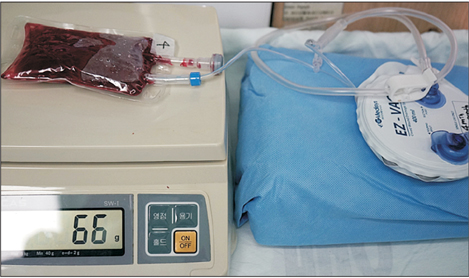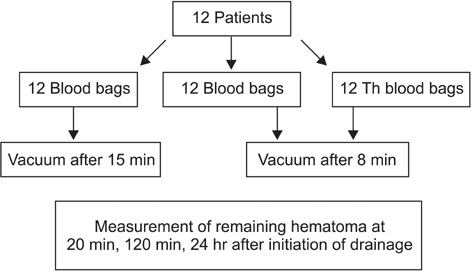Clin Orthop Surg.
2016 Dec;8(4):407-411. 10.4055/cios.2016.8.4.407.
Why Cannot Suction Drains Prevent Postoperative Spinal Epidural Hematoma?
- Affiliations
-
- 1Department of Orthopedic Surgery, Seoul Sacred Heart General Hospital, Seoul, Korea. dr.wonshik@hanmail.net
- KMID: 2412323
- DOI: http://doi.org/10.4055/cios.2016.8.4.407
Abstract
- BACKGROUND
Postoperative spinal epidural hematoma (POSEH) is different from spontaneous or post-spinal procedure hematoma because of the application of suction drains. However, it appeared that suction drains were not effective for prevention of POSEH in previous studies. The purpose of this study was to test our hypothesis that POSEH can be caused by hypercoagulability.
METHODS
This was an experimental study. One hundred fifty milliliters of blood was donated from each of the 12 consecutive patients who underwent spine surgery and infused into 3 saline bags of 50 mL each. One of the 3 bags in each set contained 5,000 units of thrombin. All of them were connected to 120 ± 30 mmHg vacuum suctions: drainage was started 8 minutes after connection to the vacuum system for 12 normal blood bags (BV8) and 12 thrombin-containing blood bags (TBV8) and 15 minutes after connection for the remaining 12 normal blood bags (BV15). The amount of initial and remaining hematoma at 20 minutes, 120 minutes, and 24 hours after vacuum application were measured by their weight (g). The primary endpoint was the difference between BV8 and TBV8. The secondary end point was the difference between BV8 and BV15.
RESULTS
The remaining hematoma in TBV8 was significantly greater than that in BV8 at all measurement points: 46.3 ± 12.4 vs. 17.0 ± 1.3 (p = 0.000) at 20 minutes; 33.0 ± 8.2 vs. 16.3 ± 1.2 (p = 0.000) at 120 minutes; and 26.1 ± 4.0 vs. 15.8 ± 1.6 (p = 0.000) at 24 hours after vacuum application. The remaining hematoma of BV15 was significantly greater than that of BV8 at all measurement points: 30.0 ± 12.0 vs. 17.0 ± 1.3 (p = 0.002) at 20 minutes; 24.2 ± 7.6 vs. 16.3 ± 1.2 at 120 minutes (p = 0.002); and 22.2 ± 6.6 vs. 15.8 ± 1.6 (p = 0.004) at 24 hours after vacuum application.
CONCLUSIONS
With a suction drain in place, the amount of remaining hematoma could be affected by coagulability. Thrombin-containing local hemostatics and the length of time elapsed before the commencement of suction resulted in hypercoagulability, indicating these two factors could be causes of POSEH.
MeSH Terms
Figure
Reference
-
1. Korinth MC, Gilsbach JM, Weinzierl MR. Low-dose aspirin before spinal surgery: results of a survey among neurosurgeons in Germany. Eur Spine J. 2007; 16(3):365–372.
Article2. Cuellar JM, Petrizzo A, Vaswani R, Goldstein JA, Bendo JA. Does aspirin administration increase perioperative morbidity in patients with cardiac stents undergoing spinal surgery? Spine (Phila Pa 1976). 2015; 40(9):629–635.
Article3. Awad JN, Kebaish KM, Donigan J, Cohen DB, Kostuik JP. Analysis of the risk factors for the development of postoperative spinal epidural haematoma. J Bone Joint Surg Br. 2005; 87(9):1248–1252.
Article4. Brown MD, Brookfield KF. A randomized study of closed wound suction drainage for extensive lumbar spine surgery. Spine (Phila Pa 1976). 2004; 29(10):1066–1068.
Article5. Cabana F, Pointillart V, Vital J, Senegas J. Postoperative compressive spinal epidural hematomas: 15 cases and a review of the literature. Rev Chir Orthop Reparatrice Appar Mot. 2000; 86(4):335–345.6. Chimenti P, Molinari R. Post-operative spinal epidural hematoma causing American Spinal Injury Association B spinal cord injury in patients with suction wound drains. J Spinal Cord Med. 2013; 36(3):213–219.
Article7. Kou J, Fischgrund J, Biddinger A, Herkowitz H. Risk factors for spinal epidural hematoma after spinal surgery. Spine (Phila Pa 1976). 2002; 27(15):1670–1673.
Article8. Parker MJ, Livingstone V, Clifton R, McKee A. Closed suction surgical wound drainage after orthopaedic surgery. Cochrane Database Syst Rev. 2007; (3):CD001825.
Article9. Scuderi GJ, Brusovanik GV, Fitzhenry LN, Vaccaro AR. Is wound drainage necessary after lumbar spinal fusion surgery? Med Sci Monit. 2005; 11(2):CR64–CR66.10. Uribe J, Moza K, Jimenez O, Green B, Levi AD. Delayed postoperative spinal epidural hematomas. Spine J. 2003; 3(2):125–129.
Article11. Walid MS, Abbara M, Tolaymat A, et al. The role of drains in lumbar spine fusion. World Neurosurg. 2012; 77(3-4):564–568.
Article12. Yi S, Yoon DH, Kim KN, Kim SH, Shin HC. Postoperative spinal epidural hematoma: risk factor and clinical outcome. Yonsei Med J. 2006; 47(3):326–332.
Article13. Mirzai H, Eminoglu M, Orguc S. Are drains useful for lumbar disc surgery? A prospective, randomized clinical study. J Spinal Disord Tech. 2006; 19(3):171–177.14. Kebaish KM, Awad JN. Spinal epidural hematoma causing acute cauda equina syndrome. Neurosurg Focus. 2004; 16(6):e1.15. Sokolowski MJ, Garvey TA, Perl J 2nd, et al. Prospective study of postoperative lumbar epidural hematoma: incidence and risk factors. Spine (Phila Pa 1976). 2008; 33(1):108–113.16. Emori M, Takebayashi T, Imoto K, Ueno S, Mizuno S, Yamashita T. Spinal surgery in a patient with essential thrombocythemia resulting in leg paraplegia: a case report. Spine J. 2013; 13(11):e7–e10.17. Ahn DK, Jung WS, Lee JI. Hemophilia A in a senior patient: a case report of spinal epidural hematoma as first presentation. Asian Spine J. 2015; 9(3):452–455.
Article18. Babayev R, Eksi MS. Spontaneous thoracic epidural hematoma: a case report and literature review. Childs Nerv Syst. 2016; 32(1):181–187.
Article19. Tawk C, El Hajj Moussa M, Zgheib R, Nohra G. Spontaneous epidural hematoma of the spine associated with oral anticoagulants: 3 case studies. Int J Surg Case Rep. 2015; 13:8–11.
Article
- Full Text Links
- Actions
-
Cited
- CITED
-
- Close
- Share
- Similar articles
-
- Can We Prevent a Postoperative Spinal Epidural Hematoma by Using Larger Diameter Suction Drains?
- Spontaneous Spinal Epidural Hematoma
- The Efficacy of Suction Drains arter Total Hip Arthroplasty
- Is Closed-Suction Drainage Essential after Minimally Invasive Lumbar Fusion Surgery?: A Retrospective Review of 381 Cases
- Thoracolumbar Epidural Hematoma Complicated by Cauda Equina Syndrome : Complication of Systemic Heparinization Following Epidural Anesthesia: A case report



